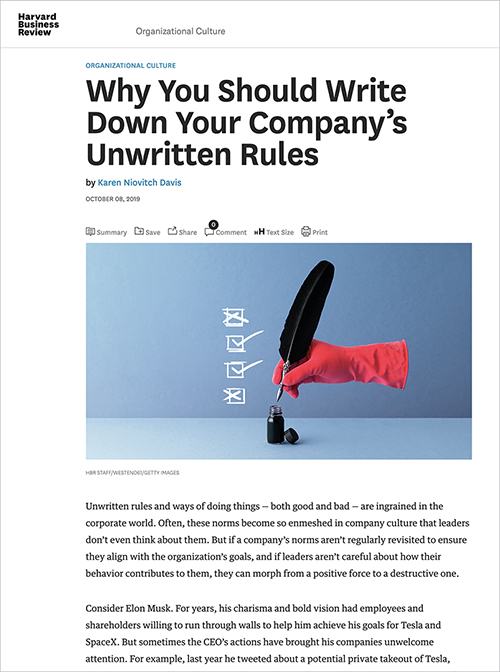Unwritten rules and ways of doing things — both good and bad — are ingrained in the corporate world. Often, these norms become so enmeshed in company culture that leaders don’t even think about them. But if a company’s norms aren’t regularly revisited to ensure they align with the organization’s goals, and if leaders aren’t careful about how their behavior contributes to them, they can morph from a positive force to a destructive one.
Consider Elon Musk. For years, his charisma and bold vision had employees and shareholders willing to run through walls to help him achieve his goals for Tesla and SpaceX. But sometimes the CEO’s actions have brought his companies unwelcome attention. For example, last year he tweeted about a potential private takeout of Tesla, which never materialized but boosted its stock anyway (and promptly caught the eye of the Securities and Exchange Commission). Some of his statements about the company’s ability to produce self-driving cars include timeframes that seem optimistic, if not pure fantasy. And last September, when Musk smoked marijuana and drank whiskey on a raucous Joe Rogan podcast, the chief accounting officer and head of HR at Tesla both resigned hours later and its stock price dropped 10%. A few months later NASA, which works with SpaceX, ordered a workplace culture and safety review of that company.
Whether they’re intended to or not, actions like Musk’s signal to employees what kind of leader they’re following and what kind of company they’re working for. If the CEO can smoke marijuana publicly, what does that tell employees about how they should conduct themselves? If the CEO can overpromise and underdeliver to shareholders and customers, what does that tell rank-and-file workers about how they should do their jobs?
Or consider the executive team at Facebook, which never told employees to ignore security and privacy issues, but did create a work environment that many say prized growth above all. That norm helped Facebook become a multibillion-dollar success, but it also contributed to the company’s recent problems around how it protects user data.
Of course, signaling how employees should act, rather than directly stating it, is sometimes an effective way to communicate. Being explicit all the time is not only cumbersome; it can also seem patronizing or insulting.
But even in company cultures that are built around solid norms, it’s a good idea for leaders to assess the unstated rules, behaviors, and expectations from time to time. Here’s how:
Write out the unwritten rules. By their nature, unwritten rules don’t exist anywhere but in people’s minds. Ask yourself what norms your employees are holding in their heads, and then get them on paper. Do your employees think the best way to get ahead is to do whatever senior leaders say, or to show that they can think for themselves? Do they think promotions are meted out fairly, or just go to people who gossip with the boss? Until there’s agreement on what perceptions exist, it’s impossible to address or change them. You should also ask your rank-and-file employees what they think your company’s norms are. You may be surprised what you learn.
Challenge your accepted norms. Leadership should sit down at least once a year and evaluate whether the unspoken norms reflect the expectations that leaders think they’ve set. Think about whether each norm helps the company achieve its goals. If a certain norm doesn’t align with how leaders want people to act, ask yourself why so many employees hold a false perception, and then implement an internal communications plan to change that. This plan will likely emphasize education and should involve leaders from the top of the organization, to emphasize how seriously management takes these misperceptions.
Overcommunicate when the goalposts move. As your business evolves, your strategy will change, which will require different behaviors from employees. But your employees can’t change their behavior if no one tells them to. For example, as a hard-charging startup grows into a mature company, long hours and a work-hard-play-hard culture may no longer be valued as much as efficiency and calm, stable leadership. Or maybe client acquisition was once the driving goal of the business, but now client retention is more important.
It’s usually not enough to simply declare a shift in focus and hope that it takes hold. If customer retention becomes a driving goal, then employees charged with achieving it should document their efforts and report them to their supervisors and colleagues. As for management, there’s going to be some repetition involved, because a new message or ethos doesn’t spread through an organization at first mention. The shift should be part of every all-hands memo, every companywide address, and every senior management meeting, so that managers can take the message to their teams. This is especially important in the early going, as many people respond to change by quietly waiting for it to go away.
Old assumptions die hard if they’re not examined and addressed. Try not to ignore the unwritten rules. It’s terrible to find out about them after an employee crossed a line because they thought it was what you wanted.
Karen Niovitch Davis is a partner and the chief human resources officer of the strategic communications firm Prosek Partners.

